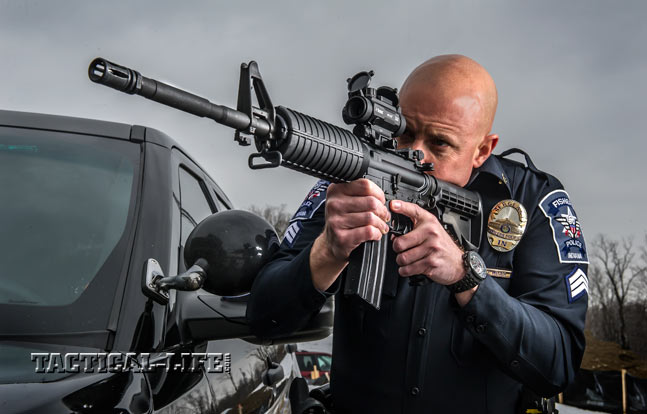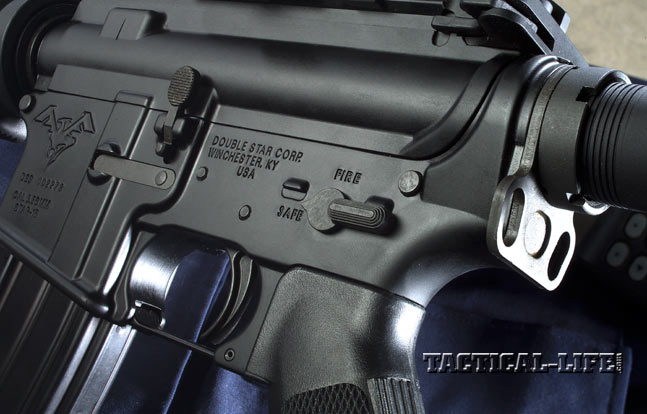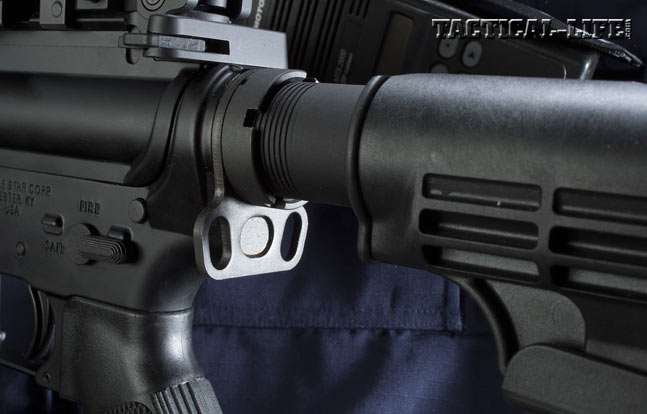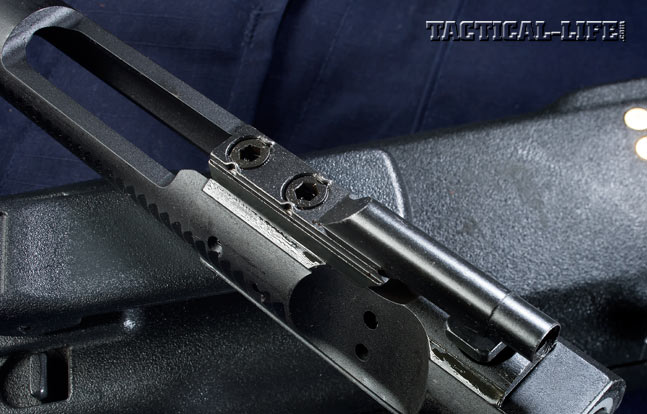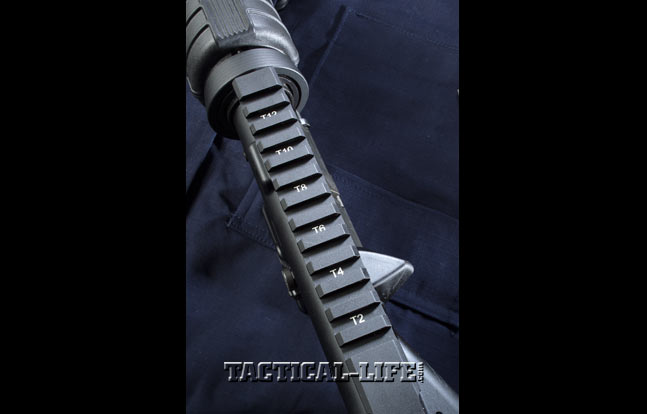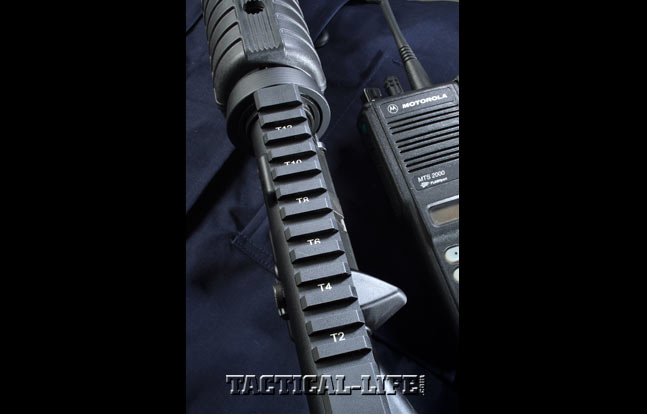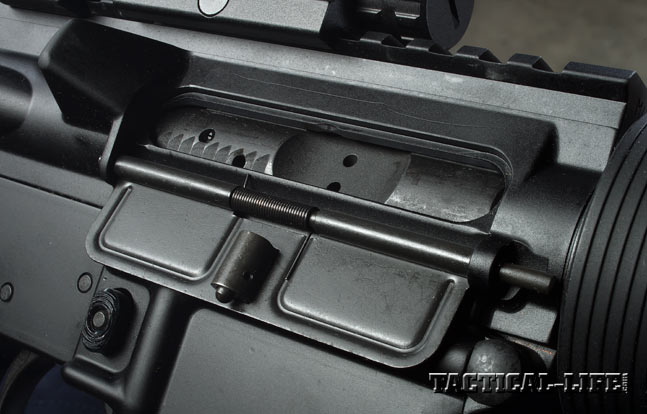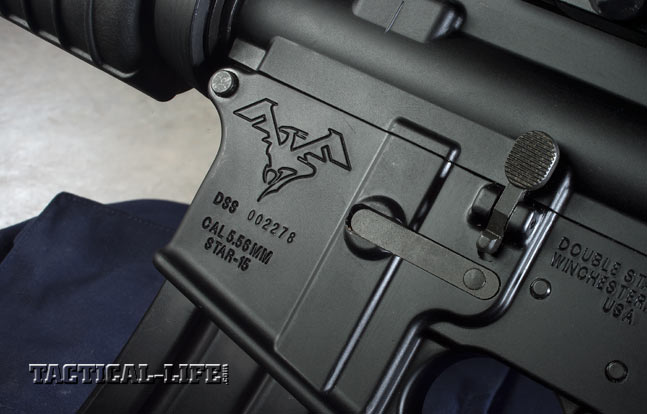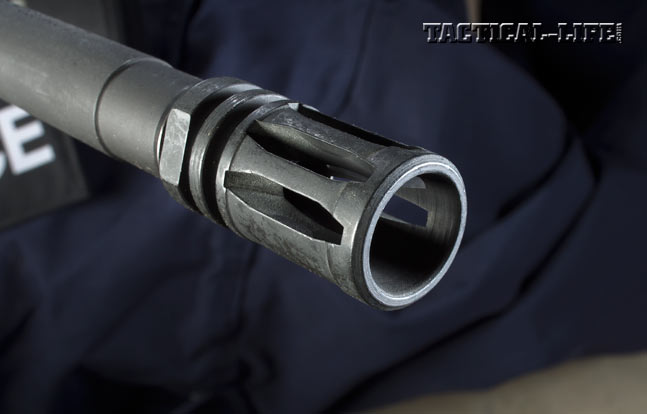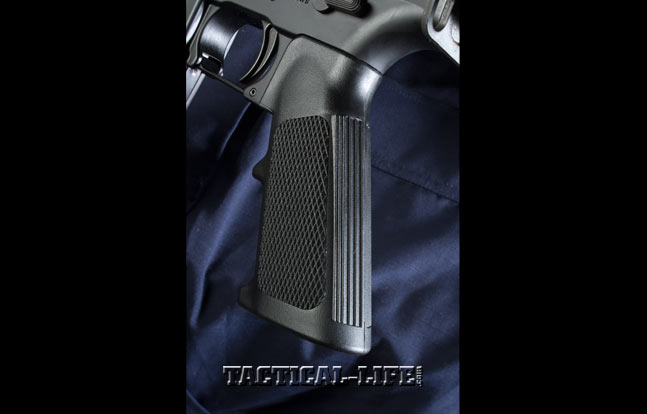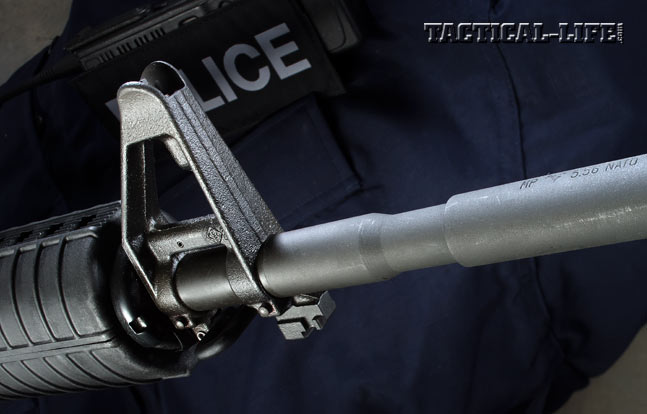“No matter what AR configuration we built, people kept asking if we had a mil-spec carbine. We didn’t because we always thought our upgraded designs were a better deal, but now we build a mil-spec version for those who want that!” This is how DoubleStar’s Nick Collier, general manager of DoubleStar and JT Distributing, explained the company’s decision to offer what it is calling the Mil-Spec Dragon.
I am quite familiar with the DoubleStar lineup, and the company offers a number of well-thought-out models. The fact that folks still wanted a truly mil-spec M4-type carbine despite all the enhancements and options DoubleStar had to offer is not surprising. Many consider “mil-spec” the gold standard. The mil-spec M4-type carbine, if executed and maintained correctly, is basic, robust and proven durable by uncounted military personnel—personnel who share at least one trait with LEOs: If it can be broken, they will break it!
Consider the robust A2-style rear sight, with its easily adjustable design using large knobs, and its application in law enforcement. At least one sight on the market was designed using A2 traits, but with an extra setscrew to meet an LE agency’s request. It seems their officers had overhead rifle racks, and during quieter moments some of the officers had developed the fidgeting habit of twisting the knobs repeatedly, then guessing at how many clicks were needed to return the sights to zero! The setscrew eliminated the fidgeting problem—at least on the sights.
Advertisement — Continue Reading Below
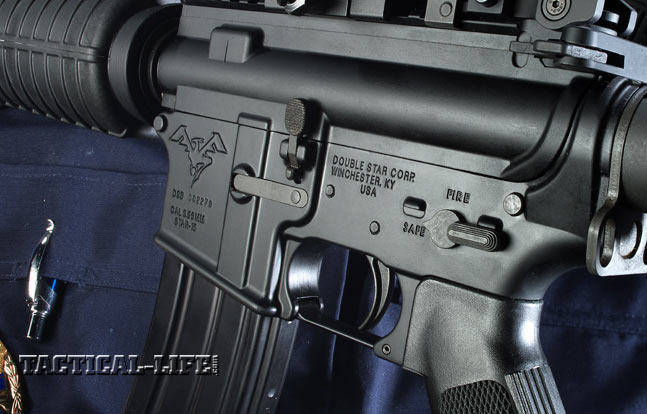
Gun Details
The DoubleStar Mil-Spec Dragon has all of the traits of a true-blue M4, without the full-auto internals and 14.5-inch barrel. Doublestar describes the rifle as being “as close to a military M4 as legally possible.” The carbine starts with mil-spec upper and lower receivers forged from 7075-T6 aluminum, with a Picatinny rail atop the A3 upper. Examples of other mil-spec features include the carbine’s 5.56mm NATO chamber and the 16-inch, M4-profile, 1-in-7-inch-twist barrel, which is made with 11595E steel.
The barrel is high-pressure (firing a proof round that is 20 percent hotter than a normal round) and magnetic-particle inspected—again just as required by military specifications—and sports a chrome-lined bore and chamber with M4 feed ramps. Standard M4 handguards cover the barrel. The Mil-Spec Dragon also comes with the M203 mounting groove in front of the forged, F-marked front sight base, which has an elevation-adjustable sight post. The barrel is finished with a step down and an A2-style birdcage flash suppressor.
Advertisement — Continue Reading Below
Of course, the Mil-Spec Dragon’s lower receiver is built using a mil-spec receiver extension tube (i.e., government not commercial), which wears a mil-spec, six-position collapsible buttstock. The standard endplate has been replaced with a DoubleStar Double Loop single-point sling adapter.
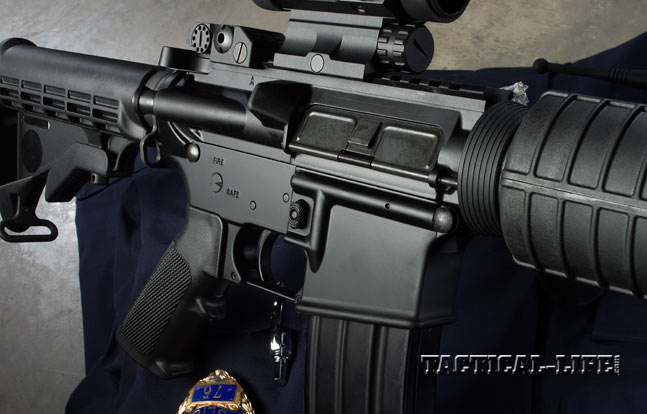
This flattop carbine does not come with a carry handle or rear sight, and my test sample arrived with an A2-style pistol grip and a single-sided safety selector. The bolt assembly, firing pin, cam pin, firing pin retainer and bolt carrier key are made to military specifications for DoubleStar by military contractors. The carrier keys are properly torqued and staked to specifications. All of the alloy parts are Type III hardcoat anodized, while the steel ones are phosphated black.
Riding in a standard triggerguard, the trigger is mil-spec with a 6.1-pound pull weight. To feed the Mil-Spec Dragon, DoubleStar includes a single 30-round alloy magazine with a black follower.
Considering all of these traits, the “bad” news is that DoubleStar’s Mil-Spec Dragon has few places to hang the abundance of accessories so many folks bolt onto their ARs—many times items just to have more things hanging off of it. Of course, on the other hand, the good news is that there are few places to hang the abundance of accessories so many folks bolt on. (However, there are ways to add the most truly necessary accessories.) This leaves the Mil-Spec Dragon at a relatively svelte weight of 6.1 pounds unloaded. Adding an optical sight, a GG&G rear backup sight, an Elzetta light in a ZFH1500B tactical flashlight mount (which attaches to the front sight tower) and a two-point Viking Tactics Wide Padded Sling still kept the weight well under 7 pounds.
Advertisement — Continue Reading Below
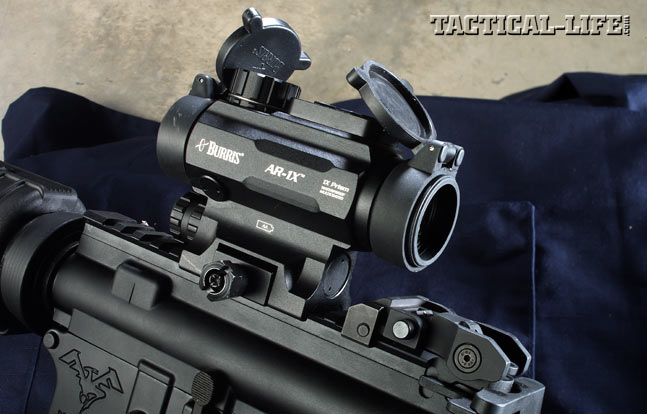
Range Time
I had two new Leupold Mark AR MOD 1 scopes on hand, a 1.5-4x20mm and a 6-18x40mm, when it came time to put the DoubleStar Mil-Spec Dragon through its paces. With its illuminated reticle and low starting power, the 1.5-4x20mm scope works well up close but still offers plenty of accuracy at distance. When it comes to squeezing the ultimate precision from a rifle, the magnification and clarity of the 6-18x40mm Mark AR MOD 1 is an immense help, as was bolting the Mil-Spec Dragon in my Caldwell Lead Sled for stability.
I also took along an assortment of magazines with the alloy version DoubleStar sends. I ended up with two polymer and two alloy versions and used them at random during the accuracy and handling tests. There wasn’t a problem with any of the magazines—they each latched into place firmly and fed reliably.
Advertisement — Continue Reading Below
“The Mil-Spec Dragon did not care which magazine was used—polymer or aluminum, they worked the same…”
The DoubleStar Mil-Spec Dragon fared well with several different bullet weights and types. Achieving almost 1-MOA accuracy for the best group of each load with bullet weights from 55 to 69 grains is never too shabby! In fact, the averages of five 5-shot groups for each load did not change appreciably, which tells me the results of shooting the same loads on any given day could produce different results, but not significantly.
Which brings up an interesting juxtaposition about mil-spec versions: As I said, a great many folks tout “mil-spec” as being the gold standard of AR construction, as shown by the demand DoubleStar continued to receive, but many in that same group also believe mil-spec will only deliver moderate accuracy. The Mil-Spec Dragon put the lie to that idea. The accuracy I obtained will certainly get the job done out to 100 yards, and noticeably beyond, with the right optics.
Speaking of optics, I switched to the 1.5-4x20mm Leupold Mark AR MOD 1 scope, turned on its FireDot illuminated reticle and ran through several exercises from 5 to 50 yards. My goal was to get more rounds through the Mil-Spec Dragon, see how it handled and get in some much-needed practice. How did it do? In a word, perfectly! The Mil-Spec Dragon did not care which magazine was used—polymer or aluminum, they worked the same.
Advertisement — Continue Reading Below
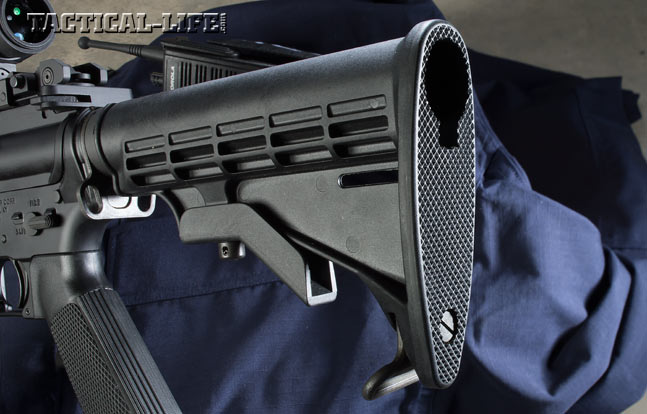
Final Thoughts
DoubleStar’s Mil-Spec Dragon handled just like most ARs; it was quick in hand, snappily moving from target to target, and its controls operated as they should. While I was actually shooting and moving—concentrating on making good hits, not what forend or stock was on the carbine—I could not tell whether I was shooting a mil-spec AR or not. I really think it’s a good thing to know that being a mil-spec carbine was not detrimental to the Mil-Spec Dragon’s operation and accuracy. Of course, nothing in the mil-spec guidelines says DoubleStar can’t put the same time and attention to detail into the Mil-Spec that it lavishes upon all of its other ARs before they leave its facility!
DoubleStar’s slogan is “Be Victorious.” Achieving that goal is why LEOs carry the plethora of things they do on their belts and in their vehicles. Each is designed to aid in protecting the public and help LEOs return home safely at the end of each shift. Patrol carbines such as the DoubleStar Mil-Spec Dragon can provide the edge needed by officers to survive and protect the public, to be victorious.
Advertisement — Continue Reading Below
